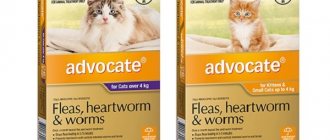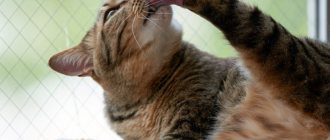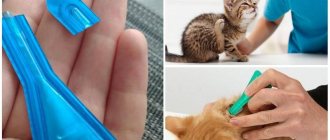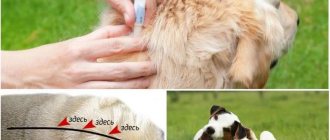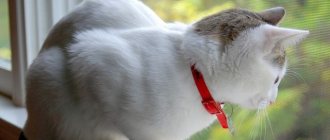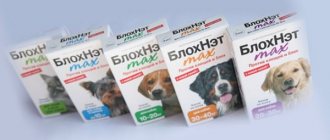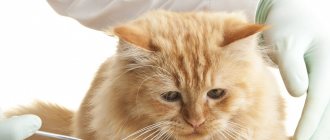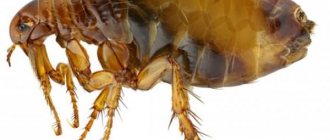Fighting parasites is a common task for cat owners. The simplest and most affordable method to quickly get rid of bloodsuckers is perhaps flea drops . Easy to apply, relatively safe for pets, inexpensive and accessible, and these are not all the advantages of the drugs.
The droplets can be applied to a place inaccessible to the animal (the withers) and not worry that the cat will lick them off or get them with its paw. In addition, many manufacturers offer us drops for kittens, which will rid the animal of parasites very quickly and will not cause harm. But in order to completely destroy bloodsuckers, certain rules must be followed.
At what age can drops be used?
Fleas are external parasites of pets. Flea bites are very itchy and can cause allergies and dermatitis in the animal. If your pet is left untreated, its fur may fall out. The body becomes vulnerable to worms and various infections. Flea infestation leads to the development of anemia, which often ends in death.
The cat is itching
A kitten can become infected immediately after birth. This occurs if the mother was not treated before pregnancy. Babies can be treated from the age of 3 months.
Before reaching this age, fleas are removed by hand, the kittens are bathed with a mild shampoo, making sure that it does not get into the baby’s eyes, mouth and nose. After bathing, you need to dry the coat with a hairdryer. Do not allow the kitten into a cold, drafty room for 8–10 hours. By licking newborns, the cat removes some of the fleas. It is advisable to wash the bed on which the cat family sleeps every day. You can comb babies with a small soft comb.
Important! Products such as spray, special collar, powder, and aerosol are not suitable for children. Moreover, if you put a collar on a kitten too early, this can lead to stunted growth and development of the pet.
Kitten after bathing
Application methods
In order for the drops to work as effectively as possible and permanently exterminate fleas, it is enough to part the animal’s fur in the right place, thoroughly rub in a couple of drops of the product and not wash the cat for about two to three days. You can also apply a number of drugs along the animal’s spine, which is why the greatest effectiveness is achieved.
Drops are applied to a place inaccessible to the cat’s tongue.
Each drug has its own dosage, and before you start treating your pet, you must also read the instructions. While applying the drops, you must constantly ensure that the animal does not accidentally lick or sniff the product, so that it does not get into the eyes, and if this happens, you must immediately rinse the area with warm water.
Flea - appearance, structure, symptoms
Fleas are found everywhere. This is a fairly large order of insects, which includes subspecies that feed on cat, dog, rat and even human blood. They differ from each other in size, color of the chitinous cover and some features of the body structure.
What does a cat flea look like?
The cat flea is one of the most common and small species among the flea order. The size of an adult insect rarely exceeds 3 mm. For comparison, fleas that feed on human blood have body sizes of up to 5 mm, and moose fleas often reach a length of 12 cm! They move quite quickly on the animal’s body, as they are perfectly adapted for movement in thick fur. They have a body that is flattened laterally, allowing them to maneuver between hairs, and long hind legs, with the help of which fleas are able to make jumps up to half a meter long.
The best anti-flea drops: rating
We present to your attention our rating of anti-flea drops for cats.
The rating of drops against ixodid ticks is presented below. The fact is that manufacturers, as a rule, focus specifically on fleas and do not always include components against ixodid ticks. After all, most cats stay at home. Only high-quality drugs are presented below. We did not include cheap products in the rating. But you need to understand that even the best drops can “break through”, that is, a tick can bite an animal and not die, but these cases are rare, and therefore, by choosing a good product, you minimize the risk that it will not work.
When choosing a drug, please note that many drops are available in several versions for different weight categories. It is very important to choose the right category.
Hartz Ultra Guard
The American company Hartz has released Ultra Guard drops for withers, which exist in variations for dogs and cats. The variation for cats works against fleas and their larvae. The active ingredient is methoprene.
Stronghold
Stronghold drops from Zoetis are available in several variations. There are variations for cats and dogs that destroy ticks (but not ixodid ticks) and insects, as well as some types of helminths. Active ingredients: selamectin and sarolaner. The dosage varies depending on the weight of the animal. You can also choose a separate type of drops that are suitable for kittens and puppies from six weeks of age. Thus, when choosing a specific modification, they take into account the weight and age of the animal, as well as the biological species (cat or dog).
Advantage
Advantage anti-flea drops from the German company Bayer for cats contain a fairly effective and safe substance, imidacloprid. It acts quickly: if there is already an infection, imidacloprid destroys fleas parasitizing the animal within 12 hours. The active substance is also interesting because it destroys flea larvae. Not all poisons can do this. The drug is approved for kittens from 8 weeks. Suitable for pregnant and lactating women.
Advocate
And again the German company Bayer. Advocate drops are available for dogs and cats (two variations). They are effective against insects, ticks (not ixodid!) and helminths. The active ingredients are imidacloprid and moxidectin. If imidacloprid is a contact drug against insects, including fleas, then moxidectin penetrates into the blood of cats and acts on internal parasites. As you have already noticed, many Bayer drops have a wide spectrum of action and are good for those owners who want to prevent and treat both helminthiasis and external parasitic diseases in one fell swoop.
How often to treat a kitten for fleas
Kittens older than 2 months need to be treated 2 times a year. But many owners carry out this procedure once every 3 months. The medicine destroys fleas and other parasites.
Flea drops for cats: remedy, tablets
First you need to try it on a small area of the kitten's skin. A small drop should be applied to the paw and see if an allergy occurs. If everything is in order, then you can safely treat the baby.
Note! It is forbidden to treat a nursing cat for worms, as this can harm her children.
Flea treatment
Operating principle
In order to understand how flea drops for cats work, you need to know that drugs in the form of drops are used only externally and are applied directly to the animal’s skin, so it is important to refrain from water treatments after the procedure. The active substance contained in it dissolves in the lipid layer of the epidermis and spreads over the entire surface of the skin, however, it does not penetrate into the blood. Thanks to this, the product can effectively act on fleas and ticks. The drops block the impulses of the nervous system, which causes paralysis, from which the parasite dies.
In the case of cats, the most effective active ingredients are:
- Fipronil;
- Diazinon;
- Moxidectin;
- Fipronil;
- Imidacloprid.
The effect of the drug can be seen in the cat's behavior. The animal stops constantly itching and becomes calmer. The drugs are highly effective, but at the same time, absolutely safe for your pet’s health. But after application, limit the animal's contact with small children for 48 hours.
Rules for applying the drug
At what age can kittens be treated for fleas?
The dose of medication depends on the age and weight of the pet. Ideally, it should be prescribed by a veterinarian: too small an amount will not get rid of parasites, and too much can lead to poisoning.
Flea treatment should be applied to the animal's withers. This is the most convenient place to apply drops and ointments, because the cat will not be able to lick the drug from there.
There are drops that need to be placed on three different places along the length of the spine, but such products are unsafe and are only suitable for very severe infections.
It is advisable to learn in advance how to place drops on the cat’s withers. In this case, you need to slightly spread the fur with your fingers and drip in 1-2 drops. You can then lightly massage the skin so that the medicine is absorbed. There is no need to rub the drops in too intensely.
How to treat a cat for fleas
How do flea and tick drops for cats work and how effective are they?
Drops are a concentrate with insecticides that are characterized by a rapid effect, but minimal toxicity. They penetrate the skin, accumulate in the sebaceous glands and act on the nervous system of parasites, causing paralysis and their rapid death. Some of the substances have an unpleasant odor for fleas, which repels them from cats.
The most common active ingredients:
- invermectin is a universal insecticide for the destruction of various types of parasites (including ticks and lice eaters), which is a highly toxic substance, therefore preparations based on it require strict adherence to the dosage;
- permethrin is a traditional substance with a relatively safe effect for warm-blooded animals, since even if it enters the stomach it breaks down and does not cause poisoning;
- pyriproxyfen is a sending substance that effectively affects not only adult parasites and larvae of parasites, but also the eggs laid by them;
- fipronil is a modern, fast-acting insecticide that is safe for the health of the treated animal and additionally prevents re-infection.
Cats are affected by several types of external parasites. The most common of them are fleas. Fleas make our pets nervous and restless. They undermine the health of the animal, weaken its immunity, cause anemia and dermatitis.
Important!
Fleas are carriers of dangerous infectious and parasitic diseases. In addition, these parasites often jump from animals to humans and bite painfully.
If you find fleas on a cat, they must be removed immediately. Special drops on the withers will help you do this. We will tell you in detail about the mechanism of action of antiparasitic drugs and the features of their use.
Preparations in the form of drops on the withers are convenient and effective. Drops are applied to the animal's skin in a place inaccessible to it. Such preparations are a solution of insecticides that are low toxic to cats and harmful to fleas.
- Bloch;
- lice;
- Vlasoedov;
- Ixodid and sarcoptoid ticks;
- Has a repellent effect against blood-sucking mosquitoes.
BlochNet max can be used on cats of all breeds. Kittens can use the drug from the age of three months. After application to the skin, the drug is evenly distributed over the surface of the animal’s body within 24-48 hours.
The accumulation of the drug occurs in:
- Skin fatty lubricant;
- Ducts of the sebaceous glands;
- Epidermis;
- Hair follicles.
All parasites will be destroyed within 1-2 days after application of the product.
The drug contains modern active ingredients in an original combination. This ensures high efficiency of BlochNet max.
- Fipronil - Has a detrimental effect on ixodid and sarcoptic ticks, fleas, lice, lice.
- Benzyl benzoate - Penetrates ticks and kills them.
- Diethyltoluamide - Repels mosquitoes from animals.
- Juvemon - Causes abnormalities in the development of parasites at the larval stage and prevents re-infection of the pet.
BlochNet max can be used on cats of all breeds. Kittens can use the drug from the age of three months.
Application rules
BlochNet max drops are used for cats that already have external parasites, as well as to prevent their attacks on the pet. Apply the drops once to the cat’s dry, intact skin in the neck area at the base of the skull (at the withers) in the following doses:
- Up to 5 kg - 0.5 ml (15 drops)
- More than 5 kg - 1 ml
- 10 kg – 20 kg – 2 ml
You should not wash or bathe the animal 48 hours before and after treatment with drops, so as not to reduce the effectiveness of their action.
The death of parasites after applying the drug to the skin of an animal is observed within 24-48 hours after treatment. After this time, your pet is free from fleas and is reliably protected.
Many cat owners are interested in the question of how often it is necessary to treat their cat for fleas.
To prevent a cat from becoming infected with fleas, treating your pet with BlochNet max should be carried out regularly once every two months.
Ectoparasites (fleas, lice eaters, ixodid ticks, etc.) are frequent uninvited guests in pets. To combat blood-sucking insects, pet supply manufacturers offer a variety of insecticidal products.
Flea and tick drops for cats have gained well-deserved popularity among owners. Ease of use, effectiveness and duration of action, versatility of products in liquid form allows them to be widely used as a complex antiparasitic agent.
Operating principle
The main components in the composition of flea and tick products
Many of the listed poisons are not only destructive to ectoparasites, but also have an unpleasant odor, acting as repellents. Drops, as a rule, are a universal antiparasitic agent with a repellent effect.
The main principle of how flea drops for cats work is as follows:
- when treating the skin of an animal, the sebaceous glands, hair follicles, and upper layers of the epidermis are saturated with insecticide;
- These substances have a contact neurotoxic effect on parasites, blocking nerve impulses, leading to paralysis and death.
As a rule, manufacturers use several insecticides belonging to different groups.
The duration of the antiparasitic effect is due to the creation of an insecticide depot in the sebaceous glands.
How long anti-flea drops for cats last depends largely on the composition of the drug. Mild drops “Stronghold” and “Frontline Spot On” protect your pet from fleas and ticks for 21 - 30 days.
We invite you to familiarize yourself with: Hemobalance, an effective vitamin preparation for cats
Drops such as “Clandestine”, which contain fipronil and permethrin, last longer - up to 2 months, which is due to a pronounced insecticidal effect.
Rules of application
Having made the choice to use a drop form of insecticide to combat and prevent ectoparasites, the owner does not always have an idea where to place the flea drops on the cat. Manufacturers of antiparasitic drugs and veterinary specialists strongly recommend applying the drug to the animal’s withers.
Important!
This place is inaccessible for licking, and the risk of insecticide entering the pet’s body will be minimized. It is also important to understand that the drug is applied not to the animal’s fur, but to the skin.
Drops against fleas and ticks are applied to the skin in doses. To avoid poisoning and intoxication, before applying flea drops, the cat must be weighed and the number of drops calculated according to the instructions for the drug.
As a rule, manufacturers place drops in special plastic blisters that resemble syringes. This makes it easier to apply the insecticide. To treat your pet, you should spread the fur at the withers and apply a certain number of drops to the skin. It is important that the skin is dry and free of damage.
The drug should not be rubbed in. After treatment, you must refrain from swimming or walking the animal in the rain for 48 hours. You should also limit contact with the treated pet of children, sick and elderly people.
How often to drip flea drops depends primarily on the type of drug used. The majority of manufacturers guarantee the effective repellent and destructive effect of their products for 30 days.
Popular foreign-made “Stronghold” drops are guaranteed to protect your pet from fleas and ticks for a period of 30 days.
Thus, Frontline Spot On drops will provide the necessary protective effect against fleas for 2 months, and against ixodid ticks for 21 days. Drops such as “Clandestine” and “Bars” act for a longer time - up to 2 months.
Ways to prevent itching in animals
Simple rules will help protect your cat from itching:
- It is necessary to wash the bedding once a month, wash the dishes daily, and buy high-quality food enriched with vitamins and minerals that will support the immune system.
- If your pet walks outside, wear a flea collar and use drops and shampoos.
- Be sure to keep your cats ears clean.
You should not immediately think that the cat is itching from drops: this is masking a more serious disease. If he does not have fleas, but the animal is itching, do not delay a visit to the veterinarian, this will protect the cat from damage to the skin and prevent serious infection.
Composition and effect of drugs
An insecticide is an active substance included in the composition of the products, which poses a mortal danger to crawling parasites. However, it does not harm cats.
The basis of most products is permethrin, which has repeatedly confirmed its effectiveness. If it enters the stomach, it is quickly broken down and removed from the body. If a large amount of permethrin accumulates, side effects may develop.
Another improved modern insecticide included in current products is fipronil. These flea drops are intended for kittens from 2 months of age and pregnant animals.
Today, drops based on pyriproxyfen are produced. Previously, it was contained in poisons that were impregnated with cat flea collars.
Another insecticide is ivermectin, which has a versatile effect. It is capable of destroying:
- ticks;
- fleas;
- nematodes
Applying drops to the withers can both repel insects and poison them. It is enough to use the product once. It will work better on pets, although it can also be used for pets who prefer to walk a lot outside. In the second case, the effectiveness of the product decreases.
The instructions for use must be strictly followed. Do not use anti-flea and anti-tick drops for cats after the specified period of use. In some cases, an allergic reaction may occur in the form of:
- dermatitis;
- hair loss;
- itching.
To prevent this from happening, you need to drip 1 drop onto the cat’s withers, constantly observing his reaction.
Safety regulations
A caring owner should always remember how to properly administer flea drops to a cat. Before use, you must carefully read the instructions for the drug and show your cat to a veterinarian to avoid allergies in your pet and other complications.
How to remove fleas from a cat at home
Drops on the withers are used only for those kittens who already eat on their own. For babies who feed on mother's milk, these drugs are contraindicated. Kittens should not be treated with products intended for adult cats.
Attention! If flea drops get into your animal's eyes, nose or mouth, rinse them immediately with water.
For 2-3 days after flea treatment, you need to carefully monitor that the cats do not lick each other. For safety, you can put a medical collar on your kittens.
Allergy to flea bites
Rating of the best flea drops
Antiparasitic agents
22.11.2017
6 min.
You can notice the appearance of fleas in cats by changes in behavior. The animal behaves restlessly and itches frequently and intensely. Over time, wounds and scabs appear on the skin. A careful examination of the fur reveals rather large, high-bouncing insects with a characteristic body flattened laterally.
In such a situation, special insecticidal preparations should be immediately used. They are divided into several groups and differ in composition, different active components and spectrum of action on parasites.
The poisonous effect of products in the form of flea drops is based on the inclusion in the structural formula of one of the types of insecticides.
- Permethrin. Effective in the fight against blood-sucking insects. It does not cause harm to animals when used correctly without exceeding doses. In case of accidental entry into the stomach, the drug is quickly broken down and subsequently excreted from the body, which prevents it from entering the blood.
- Imidacloprid. The effectiveness of this type of synthetic insecticide is not affected by environmental temperature fluctuations. It is a highly toxic substance for insects.
- Fipronil. Thanks to the improved structural formula, preparations based on this insecticide are approved for use by pregnant cats and kittens older than two months.
- Pyriproxyfen. This substance has recently been used as a base for drops. More often it is found in preparations aimed at impregnating flea collars.
- Ivermectin. Belongs to the group of broad-spectrum insecticides. Destroys not only fleas, but also nematodes and ticks.
The various flea drops produced for cats have a number of advantages:
- when applied, the possibility of the drug getting into the animal’s stomach is practically eliminated;
- quite easy to use;
- rapid action of toxic components - on average 15 minutes after the drops hit the cat’s skin.
The principle of action of the products is that insecticides not only kill, but also repel adult insects that tend to leave the cat’s body after treatment. Re-infection does not occur upon contact with other animals. The deposited larvae die.
It is necessary to follow the instructions for use of each specific medicine. The sequence of actions for different drugs against blood-sucking insects does not differ significantly. There are slight variations in dosage and you should consult your veterinarian about this as dosages vary depending on the animal's health, age and even breed.
- 1. Since most drugs for parasites are recommended to be dripped onto the withers, where the animal’s tongue cannot reach, the fur in this area is spread apart with your fingers.
- 2. Apply the required number of drops from a pipette to the skin.
- 3. To speed up absorption, carefully rub the composition with your finger (some preparations do not require this).
Applying drops
Some types of flea drops are recommended to be applied pointwise to the back along the spine. In the next three days, bathing the cat is excluded. They are not combed during this period. It is advisable not to take your pets outside for several days, especially in rainy weather. Preventive treatment is allowed once every two months.
Flea drops are usually not harmful to adult cats. Even if they are able to lick the drug from the fur, there may be increased drooling, which will go away on its own.
The most dangerous situation is if you had to treat small kittens for bloodsuckers. The cat instinctively licks them and can become poisoned from an excessive dose of the product. Death is practically excluded. Consequences may include vomiting, refusal to eat for several days, and weight loss.
Kittens can also lick each other. For this reason, the use of most drops is most often prohibited for kittens, which cannot be isolated from other animals. If the drug gets into the eyes or nose of the animal during application, it is necessary to immediately rinse it with clean water.
Flea drops can cause allergies in the animal. Therefore, careful observation of the owner is required. If severe swelling or painful itching appears, you should quickly wash off the drug with plenty of water and show your pet to a veterinarian.
The person carrying out the drop application procedure needs to protect himself by wearing rubber gloves. If symptoms of poisoning appear in the form of nausea, dizziness, take activated charcoal. Sometimes people develop an allergic rash, swelling or redness. In such a situation, you will need to use antihistamines.
It is not always possible to independently select a suitable flea drug in the form of drops, since their range is quite extensive. Analyzing information from manufacturers, reviews, and the opinions of veterinarians, we can identify several popular brands that meet the criteria of safety and effectiveness.
- Hartz. American-made drops destroy flea larvae and oviposition. They should not be used on kittens under three months of age. Apply the product to the occipital area. The effect of the drug lasts for a month, after which the procedure is repeated. The protective effect is not reduced by short-term exposure to moisture. A preliminary consultation with a veterinarian will be required regarding the use of drops for pregnant cats, aging, and sick animals.
- Beaphar. In the line of Dutch-made flea drops, you can choose varieties for kittens and adult cats, including weakened and pregnant ones. The active ingredient is a natural margosa extract that is safe for animals. Convenient packaging in disposable ampoules is offered. The contents are poured onto the withers, lightly rubbing into the skin. By repeating the procedure every 30 days, you can completely protect your pet from fleas.
- Frontline. Due to the low degree of toxicity, drops produced in France by Frontline are approved for kittens from the age of two months. Formulations are used for cats, packaged in disposable pipettes with a volume of 0.5 ml. This drug is also used to rid animals of ear scabies. It must be taken into account that after processing light-colored breeds, the wool can change its original color.
- Advantage. When considering the best drops aimed at killing fleas in cats, it is necessary to note the German drug Advantage, the base substance of which is imidacloprid. Sold in tubes, the contents of which are squeezed onto the withers once a month. The drug is approved for kittens from two months. After treatment, it is necessary to ensure that small pets do not lick the insecticide within three hours.
- Advocate. These are effective drops made in Germany, which have proven themselves as an effective preventive measure. The drug Advocate is contraindicated in weakened animals and kittens under nine months of age.
- Zookeeper. The Belarusian-made drug is distinguished by lasting results after treating cats against fleas. Allowed for kittens two months old. Not recommended for weakened pets.
There is a type of drops that are part of a series of biological products. These include the German-developed Green Fort drug. It is safe because it contains natural ingredients. But it should be borne in mind that the effect of these drops is aimed only at repelling fleas. Therefore, they are more often used as prophylactic agents.
- Bars drops, aimed at cats, have received the most widespread recognition. They destroy larvae and have a detrimental effect on insect eggs, maintaining the effect for almost three months.
- Dana-2 Ultra. The active component is low-toxic fipronil. These drops act quickly and effectively, but are recommended only for animals older than one year.
- The barrier is super. A drug that quickly destroys all generations of fleas. Allowed for kittens over three months old. The duration of exposure lasts two months.
- Inspector. Insecticidal drops that can destroy not only fleas, but also helminths. Prohibited for cats if skin damage is detected. Veterinarian permission is required for use by pregnant females and kittens weighing less than a kilogram.
- Celandine drops can be used by kittens from two months. The dosage is determined in accordance with the instructions and depends on the weight of the animal. If it is below 2 kg, then squeeze out half the contents of one pipette, that is, 0.5 ml. Pets from 3 to 5 kg require 1 ml, and over 5 and up to 10 kg - 2 ml. It is recommended to apply drops to the skin between the shoulder blades. The drug is prohibited for weak, sick animals, and pregnant cats.
We invite you to familiarize yourself with: Anthelmintic drug “Troncil-K” for cats: method of application and dosage
Timely measures taken to combat fleas will save cats from serious consequences, such as hair loss, infection with dangerous diseases and allergic manifestations. Modern drops quickly rid animals of blood-sucking insects and show high effectiveness as preventative agents.
Most often, flea drops are a solution of a strong insecticide that is low-toxic for warm-blooded animals. It consists of the following substances:
- Permethrin, which easily dissolves in the animal’s stomach if the cat accidentally licks it off;
- The active substance is fipronil, the safest insecticide;
- Pyriproxyfen, which was previously only used as a poison in flea collars;
- Ivermectin, which has a unique composition, acts in addition to fleas on a whole list of various parasites, which includes ticks, lice eaters and nematodes.
A number of the substances listed above destroy fleas not only through poison, but also simply by smell, so drops are often applied pointwise to the base of the animal’s neck just once. After this, most fleas simply scatter from the cats' bodies like rats from a sinking ship. It is the ease of application and ease of handling that make drops such a popular flea remedy.
In addition to purely domestic cats, drops can also help those animals that often go outside. They will have the most effective effect on cats that only occasionally get into fresh air - they go with their owners to the country house or out of town. This will not only help get rid of fleas, but also prevent the appearance of new ones.
Precautionary measures
- Although celandine drops are not overly toxic, it is still poison, so the following safety precautions must be observed when using the drug.
- The person performing the procedure on the cat must wear special gloves that protect the skin of their hands.
- Avoid contact of the drug with the eyes or any other mucous membranes of both yourself and your pet.
- To protect yourself from celandine entering the body, you should not eat, smoke or drink during the procedure.
- If the drug is ingested, gastric lavage should be performed.
- After the procedure, it is enough to wash your hands with soap or disinfect them.
- An empty container of celandine must be disposed of.
Allergy to toxins
If you apply flea drops correctly to the withers, the cat should not lick them off. The situation is much more complicated if the kitten is also treated with a toxic agent. Then the cat can become poisoned by licking its cubs. If there is only one kitten, then there is no need to worry too much, but if there are several kittens, you need to think through safety measures in advance.
It is better to protect the animals from each other for a couple of days. If the drug is licked by a small pet, the poison can act on it several times more powerfully. In addition, it is important to note that small kittens can grab each other by the neck while playing and thus ingest toxins.
Allergic reactions to flea drops for cats are extremely rare. But if your pet shows obvious allergy symptoms after applying the drug, and they do not go away within 1-2 days, you should urgently seek help from a veterinarian.
Dangerous symptoms include:
- itching at the site of application of the drug;
- hair loss;
- dermatitis.
A person also needs to be extremely careful when applying the drug. It is better to use gloves, and after the procedure, wash your hands thoroughly with soap. It is also recommended not to handle the animal for several days. Toxins can remain on the pet's skin, so upon contact with it, the poison can cause allergies in the owner.
But drops for cats have little toxicity for the animals themselves; such drugs act much more aggressively on fleas. Some parasites die immediately after applying the drug. This often happens when an insect gets into the area of the skin where the drops were applied. Other parasites try to escape from their host as soon as they smell an unbearable smell.
What affects the effectiveness of drops?
Success in flea control depends on the appropriate dose of medication and following safety precautions. Cleanliness in the house where a kitten lives plays a vital role in maintaining its health. It is necessary to treat not only the pet itself with flea remedies, but also the entire room. When the parasites disappear from the home, there will be no sources of infection left, which means the cat will be reliably protected from parasites.
The room can be sprayed with anti-flea spray. But a more noticeable effect will come from washing the floors with flea repellent. A small amount of the drug should be diluted in a bucket of water and the floors should be washed with this liquid.
Attention! After treating the floors in the apartment, you must carefully ensure that cats do not pick up anything from the floor or lick it.
Danger of fleas
Effective drops
Rules of application
To choose the optimal antiparasitic remedy, you should consult your veterinarian. As a last resort, when purchasing from a pet store, you need to clarify the age and weight of the pet, as well as the degree of infection. Regardless of which insecticide you choose, the main thing is to remember safety measures and adhere to the dosage indicated in the instructions so as not to harm your beloved pet.
Below is a list of modern effective drugs that are widely used in veterinary practice.
Beaphar (Bifar)
Drops in ampoules from a Dutch manufacturer that can be used to treat cats, small kittens and pets weakened after illness. A distinctive feature of the product is the absence of strong insecticides and the use of margosa plant extract as an active component. Validity period: 2-4 weeks, after which re-treatment is necessary. Thanks to their natural composition, they do not cause any particular harm to the animal, even if accidentally ingested.
We suggest you read: Signs of rabies in humans after a cat bite
A flea and tick drug from an American brand, the effectiveness of which is due to the presence of a strong substance in the composition - methoprene. The manufacturer produces the product in different dosages depending on age. According to the manufacturer, the parasites die within the first day, but due to such a strong composition, its use is not recommended for kittens under three months of age, as well as for weakened and sick animals. This product is not afraid of moisture, so it works effectively even when exposed to rain.
A powerful, low-toxic product that is suitable for controlling fleas and preventing their occurrence. It is based on imidocloprid, which, unlike most insecticides, does not have mutagenic, allergenic, sensitizing or carcinogenic effects. But you should not use Advantage on a kitten if it is not yet 2 months old.
A universal remedy with not only a therapeutic, but also a preventive effect. Its active components (fipronil and moxidectin) work effectively against severe infestations by fleas, lice eaters, demodectic and ixodid ticks. The composition is applied to dry, healthy skin in the withers area, after which it is forbidden to wash the pet for 4 days. Inspector works for two months, but is contraindicated for animals weighing up to 4 kg.
A French drug based on fipronil is available in pipettes of various dosages and is used for anti-flea treatment and deworming of cats, as well as to get rid of ear mites. Its use is approved for cats from 2 months of age. When applying the composition, the color of the coat may change, so you should not use it on the eve of exhibitions. The protective effect lasts up to 1.5 months.
A product from a domestic manufacturer based on a low-toxic insecticide (fipronil), which is not capable of causing severe harm to the animal. Despite this composition, the product is effective both in getting rid of parasites and in preventing infection. It has a strong odor, which has an additional deterrent effect. The dosage is selected taking into account weight, and for kittens after 10 weeks of age a separate mild preparation is provided.
"Celandine"
Drops based on fipronil and permethrin (in a ratio of 1:5), which are suitable for both adults and kittens (from 8 weeks). The active ingredients begin to work immediately after use and for another 1.5-2 months. They act not only on adult parasites, but also on their larvae. The drug has nothing in common with the plant of the same name, and its name only reflects the result of its use - cleansing the body of parasites.
A well-known insecticide that is effective in destroying existing parasites and preventing infection for 30 days. For adult pets, the contents of a whole pipette are used, while for young pets the dosage is calculated at the rate of 6 ml per kilogram of weight. Within a few hours after the procedure, the cat can be bathed, stroked and hugged. Stronghold is sold in a pack of three pipettes, which will be enough for the entire summer season if used correctly.
When choosing, you should take into account that even drugs that are harmless to adult pets can negatively affect the course of pregnancy, provoke disturbances in fetal development and even miscarriage. A suitable option would be drops that do not penetrate deep into the skin, have a low-toxic composition and a delicate effect. There are very few options on the market that are safe for pregnant and lactating cats. Among them:
- Frontline;
- advantage;
- Stronghold;
- Inspector.
Toxicity and side effects of flea products
Flea medications can be toxic to pets. If used incorrectly, these products cause allergies and poisoning. Allergies most often manifest themselves as redness, swelling, and itching of the skin at the site of application of the drops. But the cat’s nervous system may be damaged, and then it may experience convulsions and drooling.
To protect your furry pet, you need to carefully choose the dose of the drug and monitor for possible side effects. It is advisable that all recommendations be prescribed by a veterinarian.
Important! If any negative symptoms or changes in the animal’s behavior occur, you should immediately contact a veterinary clinic.
The cat is being combed
A must read!
Here were listed the main causes of itching that cause a cat to have a terrible desire to scratch. But there are many more reasons! It may well be that your pet licks its fur simply because it wants to scratch. But in any case, you need to monitor his behavior, namely, scratching, scratching and biting his own limbs.
To prevent the itching from returning, you should get rid of the cause rather than treat the symptoms. And for prevention, we recommend that you properly care for your cat and keep your beloved pet’s skin clean.
Unforeseen situations after use
After treating a furry pet for fleas, force majeure situations sometimes arise. If the cat had a lot of fleas, then in the first hours after using the drops these parasites become more aggressive. Because of this, the cat itches a lot. This goes away within a day.
The same thing happens if the animal suffers from flea dermatitis. In this case, severe itching is caused not so much by the action of the drops as by an allergy to flea bites.
The condition is especially dangerous when the cat suddenly develops an individual intolerance to the medicine. A cat's drug allergies should be treated by an experienced veterinarian.
Cats have fleas
Bacterial or fungal inflammation
Various opportunistic microorganisms living on your pet's skin do not harm a healthy animal. But if your cat’s body has been weakened, for example, due to some disease or lack of vitamins, then the population of “harmful” fungi and bacteria increases, causing the cat’s skin condition and general well-being to deteriorate.
The doctor will check for inflammation caused by fungus or bacteria and also conduct a smear examination. As a rule, this inflammation is not the main cause of the disease.
We suggest you read: How to deal with fleas in puppies
Advantages and disadvantages of using drops
Flea drops have many undeniable advantages over other forms of anti-flea medications.
Advantages:
- act quickly (within 20 minutes the cat will feel better, and a few days later the parasites will die);
- effective (reliably protect the cat from fleas for at least 1–2 months);
- relatively safe;
- convenient to use.
Unfortunately, this remedy is not suitable for everyone. In some cases, it needs to be replaced with other means or processing must be postponed for some time.
Flaws:
- may cause allergies;
- not suitable for small kittens, pregnant or lactating cats;
- dangerous for sick, exhausted, weakened animals.
Leopard
